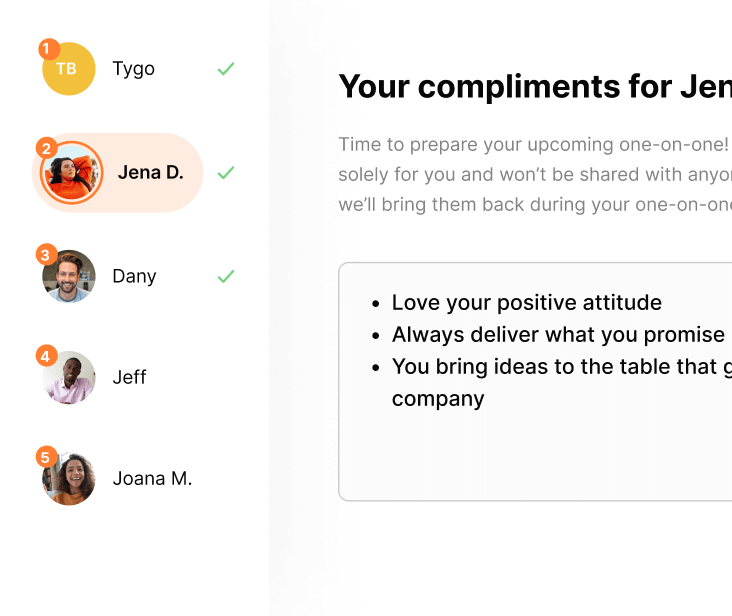Back to Blog
Employee motivation theory: Finding their why
Although motivation is a complex topic, there are a few basic theories that can help managers better understand and motivate their employees.
In this piece, we’ll explore three of the most popular employee motivation theories:
- ERG Theory
- Two-Factor Theory
- Acquired-Needs Theory
Each theory has its own strengths and weaknesses, so try to understand which one is best suited for your team. By understanding these theories, you can create a work environment that is more conducive to productivity and creativity.
What are motivation theories?
Motivation theories are frameworks for understanding what motivates humans (at work). They break down motivation into smaller pieces that help us understand and increase it.
One of the most famous motivation theories is Maslow’s hierarchy of needs. Maslow’s familiar pyramid shows that people focus on their basic motivations, like food and security, first. Then they progress to higher motivations, like self-esteem and belonging.
Some motivation theories are specifically attuned to how employees are motivated. These employee motivation theories types are from the text Organizational Behavior. They help teams to orient their workplaces and experience a strong desire to achieve success.
Share fun facts and bond with a team quiz
Have your participants choose from a list of questions they’d like their coworkers to answer about them, before watching as they guess the right answer.
01. Yes
share-fun-facts-and-bond-with-a-team-quiz

Run a guided recognition activity
Have your participants choose from a list of questions they’d like their coworkers to answer about them, before watching as they guess the right answer.
01. Yes
run-a-guided-recognition-activity

Organize a virtual cooking class
Hire a professional chef to help your team cook a delicious lunch or dinner. May be difficult for co-workers with families. To find providers and get tips, read our blog about virtual cooking classes.
02. No
organize-a-virtual-cooking-class

Hire a stand-up comedian
Have your participants choose from a list of questions they’d like their coworkers to answer about them, before watching as they guess the right answer.
02. No
hire-a-stand-up-comedian

No items found
No items found
Table of contents
Although motivation is a complex topic, there are a few basic theories that can help managers better understand and motivate their employees.
In this piece, we’ll explore three of the most popular employee motivation theories:
- ERG Theory
- Two-Factor Theory
- Acquired-Needs Theory
Each theory has its own strengths and weaknesses, so try to understand which one is best suited for your team. By understanding these theories, you can create a work environment that is more conducive to productivity and creativity.
What are motivation theories?
Motivation theories are frameworks for understanding what motivates humans (at work). They break down motivation into smaller pieces that help us understand and increase it.
One of the most famous motivation theories is Maslow’s hierarchy of needs. Maslow’s familiar pyramid shows that people focus on their basic motivations, like food and security, first. Then they progress to higher motivations, like self-esteem and belonging.
Some motivation theories are specifically attuned to how employees are motivated. These employee motivation theories types are from the text Organizational Behavior. They help teams to orient their workplaces and experience a strong desire to achieve success.
1. ERG theory
Developed in the research of Clayton Alderfer, ERG theory suggests that basic human needs fit into three categories:
- Existence, or physiological and safety needs
- Relatedness, social needs
- Growth, needs related to personal achievement and personal value
Rather than creating a hierarchy, like Maslow, Alderfer’s ERG theory shows that all three matter all the time. To apply this at work, you’d look at your team’s current experiences:
- Do they feel safe and have all their basic needs met? Low pay, for instance, can cause existence-related tension and pressure.
- Do they connect with each other and feel accepted in the group? A relatedness motivation might be at play if not, and an employee engagement solution might be in order.
- Do they see growth and feel their own value through recognition? A growth related motivation might boost their productivity or morale.
Learn more about ERG theory here.
2. Two-factor theory
While an old-school theory, Two-Factor Theory still holds sway in the world of work. Researcher Frederick Herzberg divided motivational factors into two groups.
- Hygiene factors: These factors typically were outside the job itself but influenced it. They tended to include the kind of supervision you have and your working conditions. They also include safety on the job, pay, and overall company environment and policies. Notably, even workplaces with positive hygiene weren’t enough to be motivating. Mostly, when these factors are bad, they are de-motivating.
- Motivators: These are elements of the job itself or ways that you learn that you’re good and valued at the job. This means the work is interesting to you and you gain responsibility over time. Growing your title or recognition is also a motivator.
This theory suggests that hygiene has to be good and the motivators have to be persuasive. To apply this at work, ask yourself key questions:
- Are your employees experiencing enough motivators? Are there ways to add interesting work or better recognition?
- Are your motivated employees being brought down by hygiene issues? Can you simplify complex or irritating policies or benchmark pay, for example?
- Are there factors that impact both hygiene and motivation? Sometimes, a set of team building activities can improve the overall company environment while also making employees feel more valued.
Learn more about Two-Factor Theory here.
3. Acquired-needs theory
David McClelland’s theory of Acquired Needs takes a totally different approach. McClelland suggests that people have more or less need for certain feelings at work based on their life experiences. These needs are:
- The need for achievement. A positive feeling that comes from setting and achieving goals.
- The need for affiliation. A positive feeling that comes from being well-connected and in community with others.
- The need for power. A positive feeling of being in control or in the process of gaining more control.
People’s ideal work environment provides them with ways to fulfill one or more of these needs. To apply this at work, start the conversation with your employees.
- To understand your team better, you might talk through these three needs. See whether they immediately identify with one or feel multiple needs.
- Have a brainstorming session about how your team could meet more of these needs for more employees. An employee recognition app or employee engagement platform might help here.
Learn more about Acquired-Needs theory here.
How to increase employee motivation
We’ve written extensively about increasing employee motivation. Work your way through these resources to improve motivation in your team.
- You can’t manage it until you measure it: Start by surveying employee motivation
- Use long-term strategies to build motivation over time
- If things are dire and you need immediate support, there are some short-term ideas to help increase motivation
- Consider using employee engagement apps like Gomada that also help increase employee motivation
- Leverage your values, eg., being a sustainable company by actually acting on your values. To stay in the example, you can use CSR tools and create a CSRD sustainability report regularly to make real progress on your sustainability efforts to become a 'greener' company. The first step to your sustainability report is to conduct a double materiality assessment. The Materiality Master software is the easiest way to do your materiality analysis.
Subscribe to get our latest updates
Subscribe to get our latest updates
.webp)





